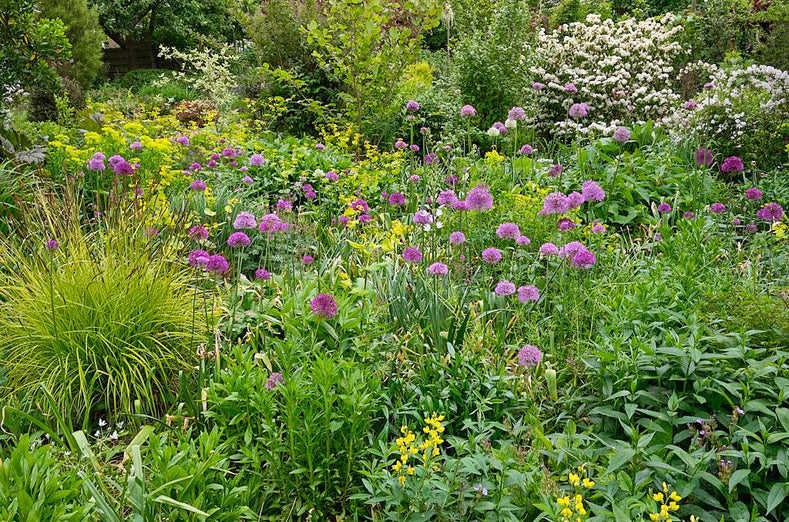At the start of summer herbaceous perennials are growing fast and many shrubs are in flower. Together they dominate the scene that was earlier the canvas for a display of popular spring flowering bulb. Now is the moment when different sorts of alliums, affectionately called ornamental onions, arrive to complete the picture by bringing excitement and dramatic colour to our gardens.
Allium ‘Purple Sensation’ is the classic ornamental onion with its fist-sized pompom flower heads that are made up of hundreds of star-shaped flowers. Its foliage, like many other allium bulbs, has played a role as ground cover so far, but as they rise up to flower their foliage dies back leaving a clean stem holding the flowers high above the surrounding vegetation.

Such ornamental onion bulbs are best planted in generous drifts throughout garden borders. A taller growing selection is Allium ‘Ambassador’ with slightly larger flowers it will be the one to place towards the back of a border. However, the most dramatic of all of these is Allium ‘Globemaster’. Its flower heads are some twice the size of ‘Purple Sensation’ and more densely packed with dark purple flowers. Remaining in flower longer than any, Allium ‘Globemaster is the one to pick for the most prominent positions in your garden.
Allium ‘Mount Everest’ is well named being tall-growing with compact white flower heads. Mix it with ‘Ambassador’ for a more intriguing effect. Just adding a few of its white flowers will make all the difference.
Allium ‘Summer Drummer’ is new to me, but promises new possibilities. It will flower later, in mid-summer, and at 2 meters tall it will need tall-growing perennial partners such as the grass Calamagostis x acutiflora or Persicaria polymorpha.
The wild bulb species Allium cristophii is my favourite ornamental onion to use within mixed perennial meadow planting schemes. Slightly shorter growing than those mentioned so far, its flower heads are larger with fewer, but larger individual flowers that creates the effect of an exploding firework. It seems to float within the fine textured grasses and early flowering salvias that feature in many of my gardens.

If the idea of exploding fireworks in your garden borders excites you, plant just a few extra bulbs of Allium schubertii. It is similar to Allium cristophii, but dramatically larger.
The drumstick allium is deservedly popular. Allium sphaerocephalon with its compact flower heads at the end of long stems is charming when seen bobbing about amidst slightly lower-growing plants. Place it randomly amongst fine textured ornamental grasses such as Nassella tenuissima and Deschampsia cespitosa.
Totally different in character is Allium bulgaricum (Nectaroscordum siculum subsp. bulgaricum) with its dangling bell-shaped flowers, up to thirty per flower head. These are soft purple with cream edges. Like snakes, the long stems twist and turn as they rise above neighbouring plants. Surprisingly, their bells turn upwards when forming seeds creating a seed head that resembles a fairytale castle for months thereafter.
Of the many other allium bulbs I use in my gardens the charming powder blue heads of Allium azureum (Syn. A. caeruleum), the size of golf balls on knee-high stems, are only effective when used in bold drifts. Whilst many of the lower-growing species such as yellow Allium moly and pink Allium roseum are certainly delightful additions to the very front edges of informal planting schemes in our summer gardens.
Ornamental onions cannot be ignored when a bridge is needed between spring and summer in your garden’s planting plan.
Michael King 10/2020
Michael King is a botanist, formerly Secretary to the Board of Trustees at Kew Gardens who has been living for the past twenty five years in Amsterdam, close to the bulb fields of Holland. A designer, tutor and garden writer, Michael is the author of magazine articles and numerous books on plants and gardens with particular reference to planting design using perennials and bulbs. He is a recognised expert on, above all, ornamental grasses and tulips.

